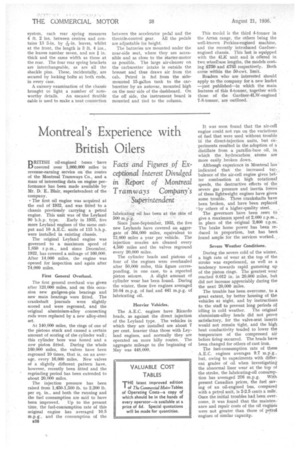Montreal's Experience with British Oilers
Page 40

If you've noticed an error in this article please click here to report it so we can fix it.
DRITISH oil-engined buses have
covered over 1,000,000 miles in revenue-earning service on the routes of the Montreal Tramways Co., and a mass of interesting data on engine performance has been made available by Mr. D. E.. Blair, superintendent of the company.
e The first oil engine was acquired at the end of 1932, and was fitted to a chassis preVionsly carrying a petrol engine. This unit was of the Leyland 90 b.h.p. type. Early in 1935, five more Leyland engines of the same output and 10 A.E.C. units of 115 b.h.p. were installed in existing chassis.
The original Leyland engine was governed to a maximum speed of 1,850 r.p.m., and since December; 1932, has covered a mileage of 160,000. After 14,000 miles, the engine was opened for inspection and again after 74,000 miles.
First General Overhaul.
The first general overhaul was given after 123,000 miles, and on this occasion new gudgeon-pin bearings and new main bearings were fitted. The crankshaft journals were slightly scored and were reground, and the original aluminium-alloy connecting rods were replaced by a new alloy-steel set.
At 140,000 miles, the rings of one of the pistons stuck and caused a certain amount of scoring of the cylinder wall; this cylinder bore was honed and a new piston fitted. During the whole 160,000 miles, the valves have been reground 10 times, that is, on an average, every 16,000 miles. New valves of a slightly different pattern have, however, recently been fitted and the regrinding period has been extended to about 20,000 miles.
The injection pressure has been raised from 1,450-1,500 lb. to 2,200 lb. per sq. in., and both the running and the fuel consumption are said to have been improved. Up to the present time, the fuel-consumption rate of this original engine has averaged. 10.5 m.p.g:, and the consumption of the B26 lubricating oil has been at the rate of 500 m.p:g.
Since June-September, 1935, the five new Leylands have covered an aggregate of 364,000 miles, equivalent to 73,000 miles a year per vehicle. The injection nozzles are cleaned every 4,500 miles and the valves reground every 20,000 miles.
The cylinder heads and pistons of four of the engines were overhauled after 50,000 miles, this figure corresponding, in one case, to a reported piston seizure. A slight amount of cylinder wear has been found. During the winter, these five 'engines averaged 10.04 m.p.g. of fuel and 441 m.p.g. of lubricating oil.
Heavier Vehicles.
The A.E.C. engines have Ricardo heads, as against the direct injection of the Leyland type. The vehicles in which they are installed are about 7 per cent, heavier than those with Leyland engines, and normally they are operated on more hilly routes. The aggregate mileage to the beginning of May was 448,000. It was soon found that the air-cell engine could not run on the variations of fuel that were used without trouble in the direct-injection units, but experiments resulted in the adoption of a distillate from a paraffin-base oil, in which the hydrocarbon atoms are more easily broken down.
Although experience in Montreal has indicated that the increased tur!.. bulence of the air-cell engine gives bet-ter combustion at high rotational speeds, the destructive effects of tlle severe gas pressure and inertia forces of these lightweight engines have given some trouble. Three crankshafts have been broken, and have been replaced 'by others of a higher-quality steel.
The governors have been reset to give a maximum speed of 2,000 r.p.m., in place of the original 2,400 r.p.m. The brake horse power has been re. duced in proportion, but has been found ample for the services worked..
Severe Weather Conditions.
During the severe cold of the winter, a high rate of wear at the top of the stroke was experienced, as well as a tendency towards rapid gumming up of the piston rings. The greatest wear reached 0.012 in. in 20,000 miles, but did not increase appreciably during the the next 20,000 miles, The trouble has been overcome, to a great extent, by better housing of the vehicles at night, and by instructions to the staff to prevent long periods Of idling in cold weather. The original aluminium-alloy heads did not prove satisfactory, for the valve-seat inserts would not remain tight, and the high heat conductivity tended to lower the temperature of the compressed air before firing occurred. The heads have been changed for others of cast iron.
The fuel-consumption rate of these. A.E.C. engines averages 9.7 m.p.g., hut, owing to experiments with different grades of oil when investigating the abnormal liner wear at the top of the stroke, the lubricating-oil consumption has averaged 276 m.p.g. With present Canadian prices, the fuel saving of an oil-engined bus, compared with a petrol unit, is 2-2.5 cents a mile. Once the initial troubles had been overcome, it was found that the maintenance and repair costs of the oil engines were not greater than those of petrol engines of similar capacity.




























































































